Written by: Ankit Pandey
The digital landscape is constantly evolving. Everyone is gushing over Blockchain’s Digital Ledger Technology (DLT) that has brought transformation in the way organizations conduct their business transactions in recent years. The “crypto craze” around is the result of the $600 billion investment in the entire cryptocurrency market in 2017, a number which is only to grow in the following years. The ongoing flurry around the technology and the huge strides it has made in the financial industry has made many to echo DLT as a disruptive technology. It is one technology that could bring fundamental changes in the industries it is applied.
Busting the myth around the applicability of blockchain, OTT industry sees a huge potential in the technology for content licensing and media distribution. For starters, it has the potential to reinvent the way content is generated, distributed and consumed. Plus, it promises to eradicate the longstanding woes of the media and broadcasting landscape which are royalty payments, copyright infringement, unauthorized access, targeted advertising, contract management etc. Most of these industry issues have left a permanent scar in the media ecosystem that is struggling against piracy, monopolistic agents, and hidden cost. So, the OTT industry’s enthusiasm for Blockchain is understandable.
Talking of piracy, blockchain brings a paradigm shift in the way a data or information is shared. Information that is shared sans any centralized control. Blockchain breathes life to this concept through Digital Ledger Technology, a database of transactions that is shared and synchronized across multiple computers and locations. Each party owns an identical copy of the information, which is automatically updated as soon as any additions are made.
Distributed Ledger Technology at a glance:
A distributed ledger technology is a form of the ledger to eliminate the need for third-party brokers between nodes. It is a database which is shared, reproduced and operated consensually between the nodes of a decentralized network. The DLT doesn’t require any central data repository. DLT is mostly used for recording transactions such as exchange of data and assets among the members of the network. Every record in the DLT has a cryptographic signature and timestamp which makes it non-editable and non-removable from the network. In the context of cryptocurrency, Tether TRC20 operates on the Tron blockchain, enabling faster and cheaper transactions compared to other network standards.
Role of Digital Ledger Technology in OTT Industry
For the media and entertainment industry, blockchain clearly presents some significant prospects in this digital era. The areas where it could bring significant implications are many. Here is what the promising technology has to offer:
Digital Rights Management(DRM)
DLT can be used to connect members through the media supply chain. Verified information can be shared easily in the network, thus, offering transparency and eliminating the manual reconciliation processes. All the parties involved in the network can share and verify the accuracy of records being entered into the ledger. It eliminated the need for third-party DRM solutions.
Digital Advertising
The digital advertising ecosystem is heavily dependent on intermediaries for targeting and personalizing ads. Using a DLT based ad exchange platform allows advertisers and publishers to trade advertising contracts efficiently.
[Read: Targeted Advertising: Role of Video Ad Server and Video Ad Network]
Transparency, Accuracy and Accelerated Payment
Using distributed ledger technology will provide artists an unprecedented control over the way their content is distributed, consumed, and paid for. Accelerated payments and better visibility into the content usage can attract more video creators to video sharing platforms.
Security and Resilience
Using a decentralized system helps in enhancing the security of assets or information transferred across the network. DLT’s ability to form a centralized settlement platform helps in providing better protection against failure.
Royalty Tracking
It is difficult to make fair payments in this digital world due to piracy. This complication in the distribution of payments can be solved by implementing DLT. Smart blockchain contracts help to ensure all the members involved in the creation of content get their share of revenue generated from it.
[Read: From Music Downloading to Online Streaming: Blockchain to Transform Online Music Consumption]
This is just the beginning of the blockchain technology. Its practical applications have made it look usable and attractive to the media and broadcast companies. Effective utilization of distributed ledger technology can bring a bright future for media and broadcast industry by making it equitable, fairer and more secure.
To know more about the role of blockchain in media and OTT industry, Download our White Paper.















Add your comment